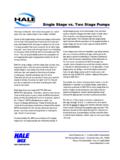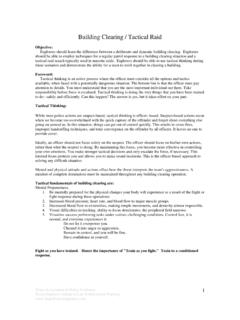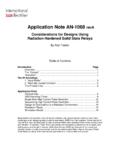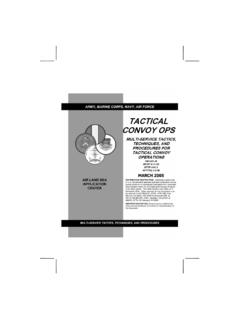Transcription of ROOF OPERATIONS - LA County Firefighters
1 roof OPERATIONSROOF OPERATIONSCOURSE OUTLINECOURSE OUTLINE IntroductionIntroduction PART IPART I--Phases of Structure FiresPhases of Structure Fires PART IIPART II-- roof ConstructionRoof Construction PART IIIPART III-- tactical ConsiderationsTactical considerations PART IVPART IV--Ventilation MethodsVentilation MethodsINTRODUCTIONINTRODUCTION A considerable portion of the annual loss of life and A considerable portion of the annual loss of life and property is a direct result of the lack of timely, property is a direct result of the lack of timely, effective ventilationeffective ventilation 80% of all fire fatalities are due to smoke inhalation80% of all fire fatalities are due to smoke inhalation More than oneMore than one--half of the nations fire loss is a direct half of the nations fire loss is a direct result of smoke and heat damageresult of smoke and heat damage Ventilation has a direct effect on all aspects of fire Ventilation has a direct effect on all aspects of fire fighting strategiesfighting strategiesPART IPART IPHASES OF STRUCTURE FIRESPHASES OF STRUCTURE FIRESPHASES OF STRUCTURE FIRESPHASES OF STRUCTURE FIRES Structure fires progress through three Structure fires progress through three basic phases:basic phases.
2 Incipient or Beginning PhaseIncipient or Beginning Phase Steady State or FreeSteady State or Free--Burning PhaseBurning Phase Hot Smoldering PhaseHot Smoldering PhaseTHE INCIPIENT / BEGINNING PHASETHE INCIPIENT / BEGINNING PHASE Oxygen content approximately 21%.Oxygen content approximately 21%. Carbon dioxide, sulfur dioxide, carbon Carbon dioxide, sulfur dioxide, carbon monoxide and water vapor and water vapor produced. The flame temperature can be above 1000 The flame temperature can be above 1000 degrees, while room temperature may only degrees, while room temperature may only be slightly elevated. be slightly elevated. Phases of FirePhases of FireSTEADY STATE / FREESTEADY STATE / FREE--BURNING PHASEBURNING PHASE Adequate oxygen and fuel sustain freeAdequate oxygen and fuel sustain free--burning and fire growth to the point of burning and fire growth to the point of full involvement of involvement of area/room.
3 MushroomingMushrooming FlashoverFlashover Phases of firePhases of fireSTEADY STATE / FREESTEADY STATE / FREE--BURNING PHASEBURNING PHASE MushroomingMushrooming Smoke and gases are and gases are heated. If confined to a room or building, they will rise If confined to a room or building, they will rise to the uppermost the uppermost level. Cooler air is displaced down towards the fire, Cooler air is displaced down towards the fire, providing oxygen and sustaining oxygen and sustaining combustion. As circulation occurs, heated smoke and gases As circulation occurs, heated smoke and gases build internal pressure that continue to rise build internal pressure that continue to rise and spread spread laterally. Phases of FirePhases of FireSTEADY STATE / FREESTEADY STATE / FREE--BURNING PHASEBURNING PHASE FlashoverFlashover A simultaneous ignition over the surface of A simultaneous ignition over the surface of the room or room or area.
4 Occurs when the heat from the fire raises Occurs when the heat from the fire raises the temperature of the contents to their the temperature of the contents to their ignition temperatures. The ignition happens in an ignition happens in an instant. Effects may be deadly to firefightersEffects may be deadly to Firefighters Phases of FirePhases of FireHOT SMOLDERING PHASEHOT SMOLDERING PHASE If the freeIf the free--burning state remains unburning state remains un--vented, vented, the fire progresses into the hot smoldering the fire progresses into the hot smoldering Low oxygen levels with little or no flame oxygen levels with little or no flame production. Temperatures in excess of 1000 in excess of 1000 degrees. Dense black smoke, that pressurizes the black smoke, that pressurizes the area. Intense heat continues to vaporize lighter heat continues to vaporize lighter fuels. These gases greatly increase the chance of a These gases greatly increase the chance of a Phases of FirePhases of FireHOT SMOLDERING PHASEHOT SMOLDERING PHASE BackdraftBackdraft A confined area that is teeming with A confined area that is teeming with pressurized, heated and flammable , heated and flammable gases.
5 The introduction of oxygen to this fuelThe introduction of oxygen to this fuel--rich rich environment will result in an explosion of environment will result in an explosion of significant intensity. Effects may be deadly to firefightersEffects may be deadly to Firefighters Phases of FirePhases of FirePart IIPart IIROOFROOFCONSTRUCTIONCONSTRUCTIONRoof ConstructionRoof Construction The Firefighters ability to safely and efficiently The Firefighters ability to safely and efficiently ventilate a building through the roof will ventilate a building through the roof will depend to some degree on his understanding depend to some degree on his understanding of roof constructionof roof construction It is essential that Firefighters become familiar It is essential that Firefighters become familiar with the existing and newly constructed with the existing and newly constructed buildings within their response areabuildings within their response areaRoof ConstructionRoof Construction Conventional Conventional VSVSL
6 IghtweightLightweightCONVENTIONAL CONVENTIONAL CONSTRUCTIONCONSTRUCTION Structural members depend on size for Structural members depend on size for Less surface area exposed to surface area exposed to fire. The larger the size of a structural The larger the size of a structural member, the longer it will take to fail member, the longer it will take to fail when exposed to exposed to fire. Potentially longer burn time results in a Potentially longer burn time results in a greater window of safety for fire greater window of safety for fire ConstructionConventional Construction roof ConstructionRoof ConstructionArched TrussesArched Trusses Buildings built during the 1930 Buildings built during the 1930 s and s and 19401940 s commonly used truss s commonly used truss Truss members have the same strength Truss members have the same strength relationships as lightweight only much relationships as lightweight only much roof ConstructionRoof ConstructionBridge TrussesBridge Trusses Buildings built in the 1920 Buildings built in the 1920 ss--19401940 s s not as common as the archnot as common as the arch Roofs vary in size and slightly in Roofs vary in size and slightly in designdesign Top surface is basically a flat roofTop surface is basically a flat roof roof
7 ConstructionRoof ConstructionConventional ResidentialConventional Residential roof ConstructionRoof ConstructionConventional ResidentialConventional Residential roof ConstructionRoof ConstructionRAFTERS AND SPACE RAFTERS AND SPACE SHEETINGSHEETING roof ConstructionRoof ConstructionConventional ConstructionConventional Construction Firefighter ConcernsFirefighter Concerns Generally sound constructionGenerally sound construction Strongest areas of these roofs are ridges, Strongest areas of these roofs are ridges, hips, valleys, over trusses and where hips, valleys, over trusses and where rafters cross outside wallsrafters cross outside walls Size of structural member dictates fire Size of structural member dictates fire exposure time prior to failureexposure time prior to failure Heat holes are acceptable and preferred Heat holes are acceptable and preferred with this type of constructionwith this type of construction roof ConstructionRoof ConstructionLIGHTWEIGHT LIGHTWEIGHT CONSTRUCTIONCONSTRUCTION roof ConstructionRoof ConstructionLightweight construction:Lightweight construction: Does not derive its strength from not derive its strength from size.
8 Strength obtained from multiple Strength obtained from multiple members in compression and in compression and tension. Involves the use of less fire resistive Involves the use of less fire resistive Provides less time to ventilate before Provides less time to ventilate before the roof becomes roof becomes unstable. roof ConstructionRoof ConstructionLightweight ConstructionLightweight Construction General RulesGeneral Rules Expect early and complete collapseExpect early and complete collapse No heat holesNo heat holes Cut vent holes well ahead of fireCut vent holes well ahead of fire 3/83/8--1/21/2 decking offers little resistance to decking offers little resistance to firefire Time on these roofs is very limitedTime on these roofs is very limited roof ConstructionRoof ConstructionMajor types of Lightweight roof Major types of Lightweight roof constructionconstruction Metal Gusset Plate Gusset Plate Trusses.
9 Wooden Wooden II Open Web Truss. Open Web Truss. Open Web Steel Joist Open Web Steel Joist PanelizedPanelized roof ConstructionRoof ConstructionMetal Gusset Plate Trusses:Metal Gusset Plate Trusses: Common in residential and commercial Common in residential and commercial Usually 2 Usually 2 x 4x 4 lumber butt jointed and held lumber butt jointed and held together by metal gusset plates commonly together by metal gusset plates commonly known as known as gang nailgang nail which are 3/8which are 3/8 in depth. Characterized by a top (compression) chord Characterized by a top (compression) chord and bottom (tension) bottom (tension) chord. Spans up to 80 Spans up to 80 with trusses 2with trusses 2 on centeron center roof ConstructionRoof ConstructionLightweight CommercialLightweight Commercial Metal gusset plateMetal gusset plate roof ConstructionRoof ConstructionMetal Gusset PlatesMetal Gusset Plates roof ConstructionRoof ConstructionMetal Gusset PlatesMetal Gusset Plates Burn testBurn test--structural collapse structural collapse 1min.
10 20 direct flame 1min. 20 direct flame impingementimpingement roof ConstructionRoof ConstructionMetal Gusset platesMetal Gusset plates Firefighter ConcernsFirefighter Concerns Gusset plates increase charring at joints Gusset plates increase charring at joints resulting in failureresulting in failure Bottom chord or web failure causes truss Bottom chord or web failure causes truss failurefailure Open space between chords promotes fire Open space between chords promotes fire spreadspread roof ConstructionRoof ConstructionWooden Wooden II Beam:Beam: Top and bottom chord of 2 Top and bottom chord of 2 x 3x 3 or 2or 2 x x 44 .. The stem is normally 3/8 The stem is normally 3/8 plywood or plywood or OSB glued in glued in place. Common spacing is 2 Common spacing is 2 on center. Strongest location is where the roof Strongest location is where the roof meets the exterior the exterior wall.










